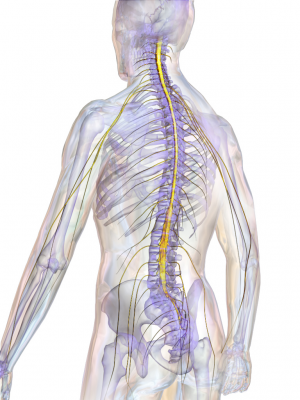Your Child's Hospital Journey
 Back Pain
Back Pain
Back pain is common in children, particularly during adolescence. Some causes of back pain in young people include poor posture, inappropriate forms of exercise and carrying heavy schoolbags.
Causes of back pain in children
While a single incident can cause sudden spinal injury, cases of nagging, ongoing back pain seem to be caused by a range of factors working in combination. Relatively minor injuries as a result of normal sports and games may lead to muscle spasm, so some back muscles may have to work harder than others. This can cause fatigue, pain and changes in posture. Poor posture can further contribute to back pain. A child with a sore back may avoid sporting activities, and the lack of exercise may then cause further problems. Many things can lead to back pain in children, including:
- Gender – back pain is more common in females
- Age – children at 12 years and over experience significantly more back pain than younger children
- Obesity and poor posture
- Heavy schoolbags carried on one shoulder or in one hand
- Incorrectly packed backpacks
- Sedentary (sitting down) lifestyle, such as watching a lot of television or sitting or lying down in front of the computer
- Injuries caused by vigorous sports such as football or horse riding, flexibility-dependent sports such as gymnastics or dance, and power sports such as weightlifting or rowing
- Soft tissue injuries, such as strains and sprains
- Competitive sports that demand intense training – for example, tight thigh muscles can trigger lower back pain.
- Medical conditions (Scoliosis, Juvenile arthritis, Injury, Spondylosis, Scheuermann’s disease)
Symptoms
It is important to check with a doctor if your child reports severe or progressively worsening back pain, pain that lasts more than several days, or pain that is associated with other warning signs such as:
- High temperature/Fever.
- Unexplained Weight loss.
- Night pain or pain at rest.
- Trouble walking.
- Weakness in legs or arms.
- Numbness or decreased feeling in the leg or foot.
- Pain that goes down one or both legs.
- Bowel or bladder problems.
- The child is younger than 6 years old.
Treatment
Stay active
One of the most important things you can do is to keep moving and continue with your normal activities as much as possible.
It used to be thought that bed rest would help you recover from a bad back, but it's now known that people who remain active are likely to recover more quickly.
Higher impact activities such as PE/Sports/Running may need to be reduced and returned to gradually as the pain improves.
This may be difficult at first, but don't be discouraged – your pain will start to improve eventually. Consider taking painkillers if the pain is stopping you from carrying on as normal.
If the child has had time off school there's no need to wait until they are completely pain-free before returning. Going back to school/collage will help to return to a normal pattern of activity and may distract from the pain.
Back exercises and stretches
Simple back exercises and stretches can often help reduce back pain. These can be carried out at home as often as you need to.
Posture
Posture is the position in which you hold your body and limbs when standing, sitting or lying down.
To have good posture means that you need to be aware of always holding yourself in a way that puts the least strain on your back, whatever you are doing.
Having good posture means that:
- Your bones and joints are in line so that muscles can be used properly.
- Ligaments holding the spine together are not being stressed.
- You don't get tired as quickly
- You don't get pain in your back or other muscles.
- Regular exercise like running, walking, cycling and playing different sports will help to keep your back strong.
-
https://www.nhs.uk/live-well/exercise/common-posture-mistakes-and-fixes/
Painkillers
Non-steroidal anti-inflammatory drugs (NSAID) tablets, such as ibuprofen, can help relieve back pain. Many types are available to buy from pharmacies or supermarkets without a prescription.
But NSAIDs aren't suitable for everyone, so check the box or leaflet to see whether you can take the medicine first. Speak to a pharmacist if you're not sure. Paracetamol/Capol can also be used for pain relief, always check the label for dosage instructions.
Hot and cold packs
Some people find that heat – for example, a hot bath or a hot water bottle placed on the affected area – helps ease the pain when back pain first starts.
Cold, such as an ice pack or a bag of frozen vegetables, placed on the painful area can also help in the short-term. However, don't put the ice directly on your skin, as it might cause a cold burn. Wrap an ice pack or bag of frozen vegetables in a cloth first.
Simple back pain should ease by 2-4 weeks and resolve by 6 weeks. See your GP if the pain doesn't improve.
